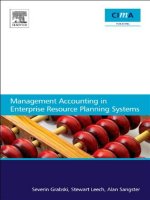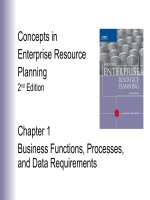Concepts in enterprise resource planning 4th ellen monk wagner production and supply chain MIS ch04
Bạn đang xem bản rút gọn của tài liệu. Xem và tải ngay bản đầy đủ của tài liệu tại đây (1.03 MB, 56 trang )
Concepts in Enterprise
Resource Planning
Fourth Edition
Chapter Four
Production and Supply Chain
Management Information Systems
Objectives
After completing this chapter, you will be able to:
• Describe the steps in the production planning process
of a high-volume manufacturer such as Fitter Snacker
• Describe Fitter Snacker’s production and materials
management problems
• Describe how a structured process for Supply Chain
Management planning enhances efficiency and
decision making
• Describe how production planning data in an ERP
system can be shared with suppliers to increase supply
chain efficiency
Concepts in Enterprise Resource Planning, Fourth Edition
2
Introduction
• Supply Chain Management (SCM) in an ERP system
• Fitter Snacker is part of a supply chain
• FS’s SCM problems and how ERP can help fix them
Concepts in Enterprise Resource Planning, Fourth Edition
3
Production Overview
• To meet customer demand efficiently, Fitter Snacker
must:
– Develop a forecast of customer demand
– Develop a production schedule to meet the
estimated demand
• ERP system is a good tool for developing and executing
production plans
• Goal of production planning is to schedule production
economically
Concepts in Enterprise Resource Planning, Fourth Edition
4
Production Overview (cont’d.)
• Three general approaches to production
– Make-to-stock items: made for inventory (the “stock”)
in anticipation of sales orders
– Make-to-order items: produced to fill specific
customer orders
– Assemble-to-order items: produced using a
combination of make-to-stock and make-to-order
processes
Concepts in Enterprise Resource Planning, Fourth Edition
5
Fitter Snacker’s Manufacturing
Process
• Fitter Snacker uses make-to-stock production
Figure 4-1 Fitter Snacker’s manufacturing process
Concepts in Enterprise Resource Planning, Fourth Edition
6
Fitter Snacker’s Manufacturing
Process (cont’d.)
• Snack bar line can produce 200 bars a minute, or
12,000 bars per hour
• Each bar weighs four ounces
• Product 48,000 ounces/hour, or 3,000 lbs/hour
• Entire production line operates on one shift a day
• Fitter Snacker’s production sequence
– Capacity: number of bars that can be produced
Concepts in Enterprise Resource Planning, Fourth Edition
7
Fitter Snacker’s Production Problems
• Fitter Snacker has problems deciding how many bars to
make and when to make them
• Communication problems
– FS’s Marketing and Sales personnel do not share
information with Production personnel
– Production personnel find it hard to deal with sudden
increases in demand
• Might cause shortages or stockout
Concepts in Enterprise Resource Planning, Fourth Edition
8
Fitter Snacker’s Production Problems
(cont’d.)
• Inventory problems
– Production manager lacks systematic method for:
• Meeting anticipated sales demand
• Adjusting production to reflect actual sales
• Accounting and purchasing problems
– Standard costs: normal costs of manufacturing a
product
– Production and Accounting must periodically
compare standard costs with actual costs and then
adjust the accounts for the inevitable differences
Concepts in Enterprise Resource Planning, Fourth Edition
9
The Production Planning Process
• Three important principles for production planning:
– Work from sales forecast and current inventory
levels to create an “aggregate” (“combined”)
production plan for all products
– Break down aggregate plan into more specific
production plans for individual products and smaller
time intervals
– Use production plan to determine raw material
requirements
Concepts in Enterprise Resource Planning, Fourth Edition
10
The SAP ERP Approach to Production
Planning
Figure 4-2 The production planning process
Concepts in Enterprise Resource Planning, Fourth Edition
11
Sales Forecasting
• SAP’s ERP system takes an integrated approach
– Whenever a sale is recorded in Sales and
Distribution (SD) module, quantity sold is recorded
as a consumption value for that material
• Simple forecasting technique
– Use a prior period’s sales and then adjust those
figures for current conditions
• To make a forecast for Fitter Snacker:
– Use previous year’s sales data in combination with
marketing initiatives to increase sales
Concepts in Enterprise Resource Planning, Fourth Edition
12
Sales Forecasting (cont’d.)
Figure 4-3 Fitter Snacker’s sales forecast for January through June
Concepts in Enterprise Resource Planning, Fourth Edition
13
Sales and Operations Planning
• Sales and operations planning (SOP)
– Input: sales forecast provided by Marketing
– Output: production plan designed to balance market
demand with production capacity
• Production plan is the input to the next step, demand
management
Concepts in Enterprise Resource Planning, Fourth Edition
14
Sales and Operations Planning
(cont’d.)
Figure 4-5 Fitter Snacker’s sales and operations plan for January through June
Concepts in Enterprise Resource Planning, Fourth Edition
15
Sales and Operations Planning
(cont’d.)
• In SAP ERP, sales forecast can be made using:
– Historical sales data from the Sales and Distribution
(SD) module
– Input from plans developed in Controlling (CO)
module
• CO module
– Profit goals for company can be set
– Sales levels needed to meet the profit goals can be
estimated
Concepts in Enterprise Resource Planning, Fourth Edition
16
Sales and Operations Planning
(cont’d.)
• Rough-cut planning: common term in manufacturing
for aggregate planning
– Disaggregated to generate detailed production
schedules
• Once SAP ERP system generates a forecast, the
planner can view the results graphically
• Rough-cut capacity planning applies simple capacityestimating techniques to the production plan to see if
the techniques are feasible
Concepts in Enterprise Resource Planning, Fourth Edition
17
Sales and Operations Planning
(cont’d.)
Figure 4-6 Sales and operations planning screen in SAP ERP
Concepts in Enterprise Resource Planning, Fourth Edition
18
Figure 4-7 Historical sales figures in SAP
Concepts in Enterprise Resource Planning, Fourth Edition
19
Sales and Operations Planning
(cont’d.)
• Historical sales screen allow planner to correct sales
values
• Do not account for external factors, such as unusual
weather
• Sales figures forecasting represent best estimate of
demand
Concepts in Enterprise Resource Planning, Fourth Edition
20
Figure 4-8 Forecasting model options in SAP ERP
Concepts in Enterprise Resource Planning, Fourth Edition
21
Sales and Operations Planning
(cont’d.)
Figure 4-9 Forecasting results presented graphically in SAP ERP
Concepts in Enterprise Resource Planning, Fourth Edition
22
Figure 4.10 Sales and operation plan with rough-cut capacity
calculation in SAP ERP
Concepts in Enterprise Resource Planning, Fourth Edition
23
Sales and Operations Planning
(cont’d.)
• Disaggregating the sales and operations plan
– Companies typically develop sales and operations
plans for product groups
– SAP ERP system allows any number of products to
be assigned to a product group
– Sales and operation plan disaggregated
• Production plan quantities specified for the group are
transferred to the individual products that make up the
group
Concepts in Enterprise Resource Planning, Fourth Edition
24
Sales and Operations Planning
(cont’d.)
Figure 4-11 Product group structure in SAP ERP
Concepts in Enterprise Resource Planning, Fourth Edition
25









